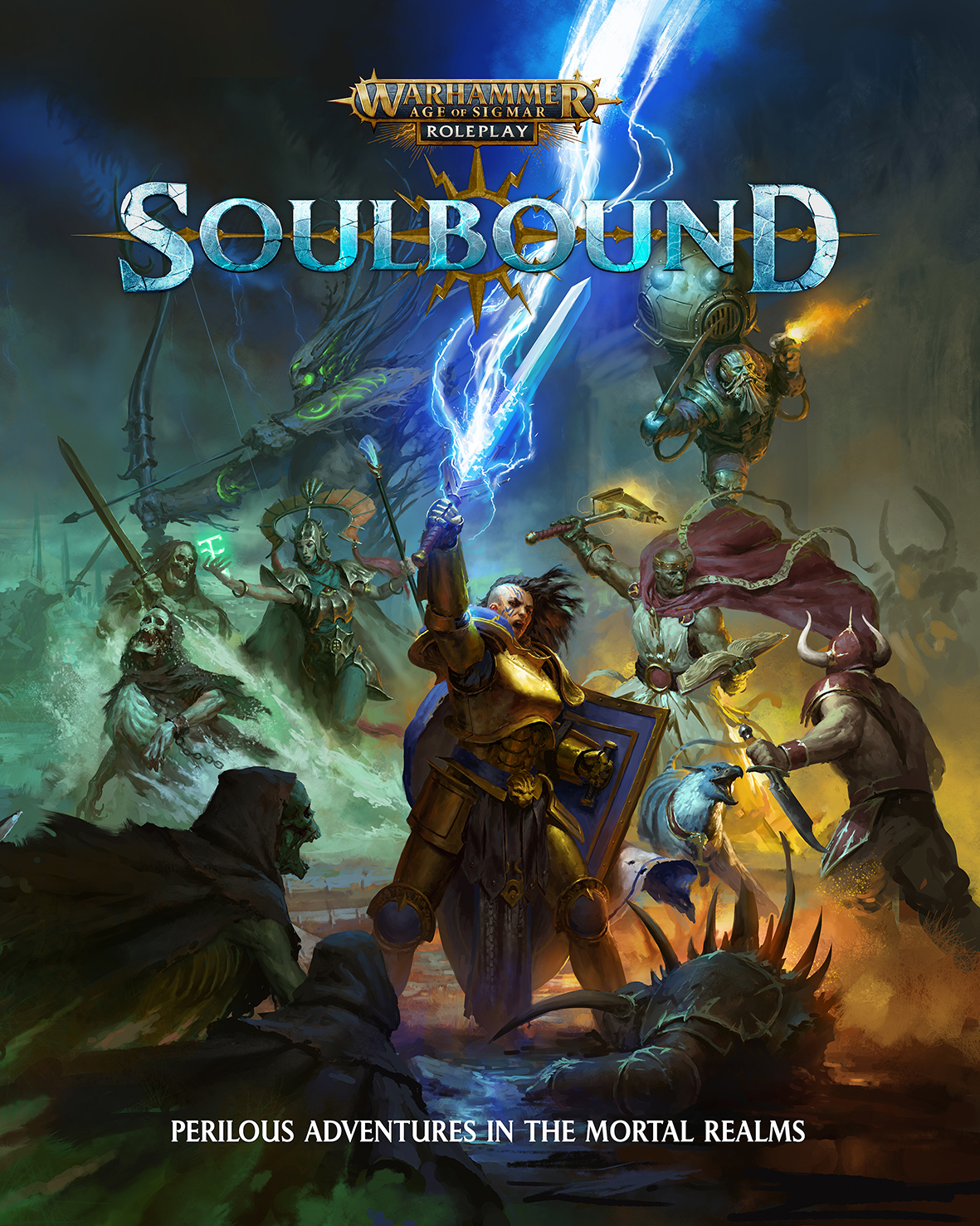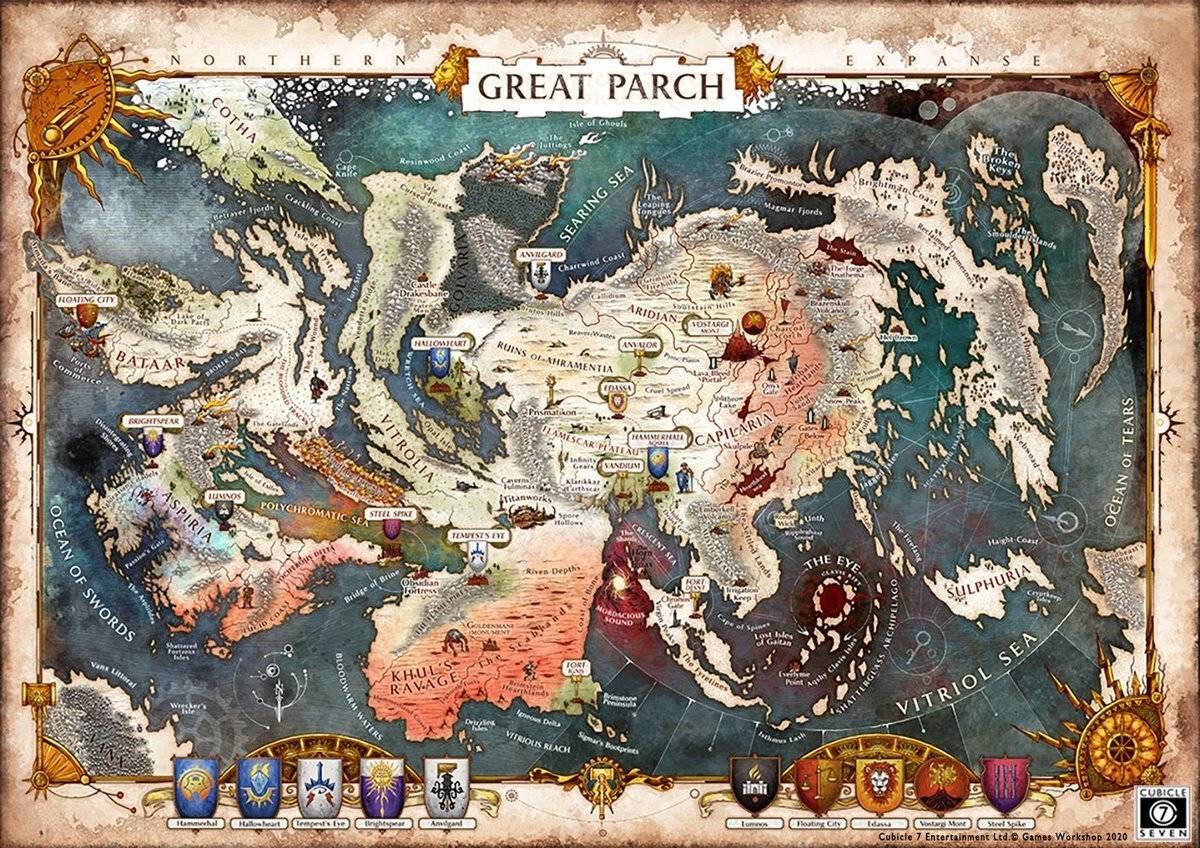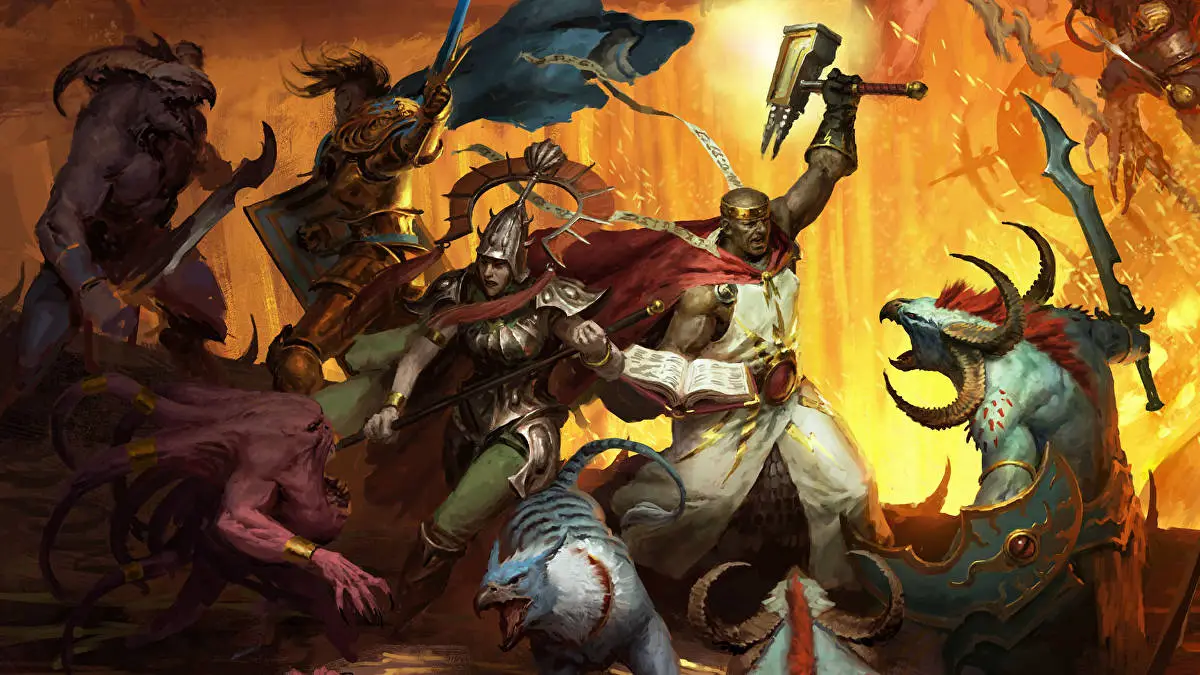Today we’re reviewing Age of Sigmar Soulbound by Cubicle 7, the TTRPG counterpart to Games Workshop’s most recent update to the venerable Warhammer Fantasy wargame setting (though Cubicle 7 still has their RPG for old Warhammer Fantasy going strong). Age of Sigmar has come a long way since its rocky start in the miniatures space back in 2015, so how does its recent RPG version hold up? The good folks at Cubicle 7 provided us a copy to check out so we can find out just that!
Bound Souls
The core concept of Soulbound is in the title. Your characters are larger than life heroes of exceptional natural talent, that have been further boosted by having their souls bound to one another, forming a binding. More than just being a fancy term for a party of adventurers, this binding has both an important narrative role and a mechanical one, boosting your powers further than any common mortal. If you haven’t guessed yet, Soulbound goes all-in on the high-magic, heroic feel. This can be felt throughout, whether it’s with the vibrant and strange worlds that are described, or in the implementation of its death mechanics, there is no doubt about the epic feel that should permeate your game.

Realms of Magic
If you’re well versed with the lore of Age of Sigmar then Soulbound is unlikely to hold many secrets for you in terms of its setting. For everyone else, however, there’s quite a bit to get through here. After the destruction of “The-World-That-Was” (which is a can of worms we’re not going to get into here), the different winds of magic coalesced into physical form, making 8 worlds in their image called “The Mortal Realms”. This is an interesting concept, as it means that each of these Realms has a very strong theme, even if it is occasionally hard to get your head around. Aqshy, the Realm of Fire, is full of deserts and volcanoes for example, and water is a rare resource. Hysh, the Realm of Light, is quite literally the sun for the other worlds, so you can live on a sun if you want to. Travel between Realms is done through Realmgates (and if the word ‘realm’ is starting to have no sense to you, I’m afraid you might find certain sections of Soulbound a bit hard to get through), which are also appropriately themed. For example, a gate leading to Shyish, the Realm of Death, will be decorated with a skeleton motif, showing that while magic can do many things in this setting, grasping subtlety isn’t one of them.
If you’re worried that next to these worlds your characters will look bland, then fear not! Dwarves (or as they are called here, the much more copyright-friendly, Duradin) might have kept their love for gold, but you’re more likely to find them riding in airships than mining in deep caves. Meanwhile, Aelves (can you guess what traditional fantasy race these are meant to be?) come in every variety from undersea pirates to murder cult blood fetishists, you know, the usual stuff. The various archetypes (classes) that are available to you are also very high fantasy. As stated, you’re going to be playing heroes with exceptional powers, either in martial prowess or accessing powerful abilities, such as magic, miracles, or techno-sorcery based equipment.

While there is no doubt that Soulbound is happening in a fantasy world unlike any other currently around, sometimes it can feel like a bit much. I regularly found myself desperately trying to remember if Ghur is the Realm of Beasts or Life, or trying to remember where Anvilgard is, or Vindicarum, or even if they had been mentioned before or not. The novelty and uniqueness of the world created is a great opportunity for creating your own story, but it can also be confusing. It also occasionally feels quite shallow, despite having nearly 100 pages of the Core Rulebook dedicated entirely to the lore. While this might seem a lot, each Realm only gets a couple of pages of description to cover its entire world, as there is just so much that they’re trying to cover. Only one region, The Great Parch in the Realm of Fire, gets any real fleshing out. This can of course be a blessing or a curse depending on your inspiration. It leaves plenty of room for you to make up your own areas, but it does leave a lot of work in your hands to try and make places unique. Some Realms might spark your creativity giving you plenty of ways to make cool and unique regions to explore, or you might completely blank on some areas and run into the problem of having too many “just a normal place but on fire this time” zones, losing the advantage of having such codified high-fantasy worlds.
Dice Pools and Difficulties
Soulbound uses a dice pool system, with your pool being a number of D6’s equal to the appropriate attribute score plus any training you might have in the skill in question. For a skill check, the Gamemaster sets the difficulty, the number that your roll needs to equal or exceed, and the complexity, the number of successful dice needed. For example, if the check is difficulty 3 and complexity 2, then you need at least 2 of your dice to equal or exceed a 3. This is quite a nifty system, though not without its flaws.
The two components of the DN (difficulty number), mean that Gamemasters are able to adjust the check to better fit the narrative. A relatively simple but hard task (jumping over a chasm, for example) might have a difficulty of 4 or 5, but a complexity of 1, meaning that just one good dice will suffice. On the other hand, you might have a relatively simple task but which has lots of steps, in which case the GM can then set the difficulty low, but require a large number of successes. In fact, some of the downtime activities detailed in the core rulebook are based on this principle (such as crafting a magic item), as they require more successes than one roll could possibly achieve, meaning that they will require multiple attempts to slowly get to the number required.
The problem however comes from the fact that it makes it incredibly hard to judge how likely someone is to succeed on their dice roll at a glance. The authors are aware of this and do provide a table to help the GM figure out how hard a check is, depending on the size of the player’s dice pool and the difficulty number of the check (even if it is buried deep in the book, in the GM section of the manual). However, this does mean that (unless you’re particularly good at probabilities) you’re going to have to refer to this table quite a lot, which can slow down the pace of the game.
This difficulty is however avoided in combat however, which is where a lot of your skill checks will happen as Soulbound is very much designed with combat in mind. In combat, you’ll mainly be using your opponent’s stats to determine the difficulty of the skill check. This also renders the fights more dynamic and adds some randomness into them, as you no longer need a predefined number of successes, simply more successes than your enemy. The inconvenience here however is that, yet again, judging difficulty remains hard to do. Soulbound doesn’t really provide much help for the GM in determining whether a particular monster is going to be a cake-walk or a TPK for the Binding, except for running simulations beforehand. Once you’re used to the system, it becomes easier to quickly judge how hard a monster is, but this is scant help for the new GM desperately trying to make combat engaging on the fly.
Aside from this difficulty on the GM end, combat feels good, which is important because Soulbound is really designed around characters being engaged in combat against the forces of chaos and undeath. It’s designed for “theatre of the mind” combat, so you’re free to play up the descriptions of your epic battle scenes without worrying about grids. This also means that battle strategy becomes more about choosing the right abilities and making tactical decisions, rather than details like exact measurements.
If you prefer grid-based combat, however, then the Core Rulebook covers all you need to convert it to how you want it to be. Your players should feel pretty good about combat whatever you chose, as dice pools mean that you get to throw a load of dice around when you make a roll (and you’ll be making quite a lot of them) which is always fun and feels impactful, even if you fail terribly. All the characters have access to at least some special quirk to give them something fun to do even if, as per usual, the more martial classes will end up defaulting to “I hit the guy with my axe” (but still with lots of dice so it’s not that bad really).

Heroes and Heroics
Stepping back from the pure nuts and bolts of the mechanics, how does Soulbound fit together? Firstly, does it fulfill its promise of “perilous adventures” as the subtitle asserts? Well… no but that’s not necessarily a bad thing. The “perilous adventure” tagline seems to be there to reference the other TTRPGs set in Games Workshop’s universes, however, I’d say that “heroic adventures” would be a much more fitting line here. The player characters are actually pretty robust in this game. Any damage they take is first taken from their toughness, which recovers after a simple 10-minute rest, and after that, they then start to take wounds, however the way that they are calculated means that you’re never going to get “one-shotted” unless you go into combat already on death’s door. There are also plenty of ways to get back up once mortally wounded, from medicine checks, using the “liquid of life” (which is also money in the game, basically meaning that you trade healing potions as currency), or indeed using the “soulfire” mechanic, which we’ll come back to shortly. All of this makes you pretty resistant to dying, and while recovering wounds can take more time than toughness (only getting them back after taking a downtime activity between adventures), there are no lingering wounds or diseases here that will penalize your character for the future, as you might find in some of the other Games Workshop TTRPGs.
Ok, back to the soulfire thing, because it actually says a lot about how the game is meant to feel. Soulfire is a party resource that can provide a lot of benefits to the players, as mentioned it can bring someone back from the brink of death, but it can also be used to reroll dice for example, among many other effects. However, to use a point of soulfire then the whole party needs to agree that the character is allowed to. If they refuse, and the player still wants to use it then they still can, however, this increases the doom counter, representing the growing influence of the Chaos Forces in the world. Doom is also increased when party members die or flee from combat, and a few other ways, while it decreases when the party accomplices certain activities to make the world a more stable place. Doom is an element used by the GM to evaluate the sate of the world, narratively making people grouchier and more aggressive as Doom increases. Doom is also used to increase the power of certain enemies, as they feed on the chaos energies infiltrating the realm.
This system very much centres your world around your characters, who are heroes whose choices have a real and inbuilt impact on the state of the world around them. A character dying mechanically increases the influence and power of the enemies in the world. There are very few games that make your player characters this exceptional. They are mighty fighters, who are very resistant to damage and have access to special powers far beyond the capabilities of the other inhabitants of the world. This very much captures the “heroic fantasy” ideal, but it does make progression slightly disappointing. You can spend your experience on a variety of things in Soulbound, but they are all small incremental advantages and, as you’re already starting from a high base level, these increases just don’t have much of an impact. This means that if you want a power fantasy then Soulbound is great right from that start, but it may start to lag in a more prolonged campaign.
Spare Bits and Paint Jobs
Anyone who dabbles in the Games Workshop miniature games will inevitably end up with a big box of spare parts from the various leftover bits from sprues, and it seems that Soulbound is keeping up on the tradition by providing plenty of extras that really elevate the game. There is a well fleshed out “downtime activities” section to spice up what happens between adventures (and in some cases, is pretty integral to certain archetypes). There are also plenty of customisation options, like the aforementioned way of translating the game to a grid format. The core rulebook also covers ways of making the game harder or removing the elements linked to the “binding” (such as soulfire) if you want to play a game with more “normal” characters, among other possible modifications.
There is also a really solid section on GM advice, which while not directly actionable is really helpful and interesting, both in general and specifically for Soulbound. In general, it covers the usual stuff about what the role of the GM is, but also talks about the importance of pacing and balancing the epic and the mundane. There is also advice about session 0, specifically in terms of setting the tone and theme of the game. There is also a decent length section about what Soulbound is. It talks about the four main tones of the game: mythic, hopeful, tragic and dark, and what they mean in this context, and also covers how to integrate mechanics into the story (such as how doom fits into the narrative, and how to weave character goals into the overall arc so as to combine an inner journey with the physical one). It really is a solid section. My only complaint is that there are some really important aspects that are hidden away in a section that is probably going to be the least-read, such as how the game uses rumours, fears, and threats to prepare and create adventures.
Hiding information is one of the recurring problems that I have with the book. The aesthetic is great, with well-chosen visuals throughout that reinforce the theme, and the artwork is just stunning. I would have liked some more full page art pieces, but that’s pretty minor given the quantity of art that’s spread out throughout the book. The layout is also solid, with decent sized text and plenty of space to break up the blocks. My main concern is in the organisation, with certain important elements hidden away in unrelated areas, and the book being generally “flippy”, but that has become increasingly standard in more complex games such as Soulbound. This will mainly be a problem during character creation, and less so during the game itself, but it’s still present. Also, for some reason Cubicle 7 continues to refuse to put their archetypes/classes in alphabetical order, splitting them up by faction instead. Since there are generally only two or three archetypes by faction here it’s less egregious than in, say, Warhammer Fantasy Roleplay, but it’s still a bit of a pain.

Binding it all together
Age of Sigmar Soulbound is a combat-heavy, high magic, power fantasy TTRPG. It’s not without its flaws, but it’s also the first edition of a new IP with a lot of power behind it. The lore might be shaky at points, but is very much in development thanks to its wargame counterpart, giving GMs a growing collection of resources to draw on. Cubicle 7 is putting out a decent amount of supplements expanding player options and providing pre-written campaigns and adventures, including a free one that fits perfectly with the Core Rulebook that you can pick up on their site or on DriveThruRPG.
While still being a “combat orientated fantasy RPG”, Soulbound differentiates itself enough to stand out among its closest competition in that space, notably of course D&D and Pathfinder. It sacrifices a part of the sense of progression to provide a higher base power level for characters, making them feel extraordinary right from the go. Its use of mechanical elements to centre the narrative around the player characters and its default to abstracted combat, rather than grid-based, provides a more cinematic feel to play.
If you’re looking for something new to try, and want it to have a very strong high fantasy feel, then Age of Sigmar: Soulbound manages to bring something fresh to the table. It’s not perfect, but very few things are, and while its level of strangeness might seem initially jarring, if you embrace the quirkiness it can really make for an incredibly refreshing one-shot, and who knows, maybe a whole campaign?
[rwp_box_criteria id=”0″]
You can grab the Age of Sigmar Soulbound Core Rulebook at the Cubicle 7 store or on DriveThru RPG. They also have a starter set coming in Q2 of this year, which you can pre-order here.
Images via Cubicle 7.
Have strong thoughts about this piece you need to share? Or maybe there’s something else on your mind you’re wanting to talk about with fellow Fandomentals? Head on over to our Community server to join in the conversation!

